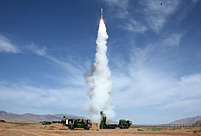As Chinese corporations flock to foreign soils to invest, some analysts cautioned that speedy expansion of the investment outflow could lead to the so-called "overheating" or "bubble" if not well managed.
However, with deepened globalization and China's ongoing economic transformation and structural reform, Chinese enterprises, especially the private sector, do have a huge space for outbound investment growth.
BIG INCREMENT BUT SMALL STOCK
The rapid growth in Chinese overseas investment has caught much global attention but can hardly cover its actually small stock. As the Economist magazine described, China is "a relative newcomer to big direct investments."
Chinese official data showed China's external direct investment hit a record of 87.8 billion U.S. dollars in 2012, making it the third largest country in outbound FDI following the United States and Japan.
However, in terms of stock, the accumulated volume of Chinese overseas investment reached 531.94 billion dollars, about one tenth of that of the United States, one third of Germany, and half of Japan.
British economist John Dunning theorized that a country's net foreign direct investment is related to its level of development -- the higher gross domestic product (GDP) per capita, the greater the scale of foreign direct investment.
Dunning argues that when a country's GDP per capita reaches between 2,500 dollars and 4,750 dollars, it will see a considerable increase in outward FDI and a balance between outward and inward FDI when the GDP per capita exceeds 4,750 dollars.
China's GDP per capita exceeded 5,400 dollars in 2011. According to Dunning's theory, the inflow and outflow of FDI will gradually balance in the future. But in fact, there is a great gap between the two.
UN statistics showed the inward FDI in China hit 121 billion dollars in 2012, 38 percent higher than the outward FDI, while the stock of the inward FDI has exceeded 1.3 trillion dollars, 2.5 times more than that of the outward FDI.
Therefore, there is a great space for the growth of China's outward FDI in the future.
In his opening speech at the Summer Davos Forum earlier this month in Dalian, a port city in northeast China, Chinese Premier Li Keqiang said China's external FDI is expected to reach 500 billion dollars in the next five years.
Daniel Rosen, co-founder of the Rhodium Group, is more optimistic. "Its (China's) stock of external direct investments will rise from less than 500 billion dollars today to 2.5-5 trillion dollars, most likely, in the coming decade," he told Xinhua.
CHINESE ENTERPRISES HAVE TO GO ABROAD
Since the "going-out" strategy was proposed officially in 2001, the Chinese economic structure has began to change.
As competition in common manufacturing has become fiercer due to increasing domestic cost and overcapacity, in addition to the need of promoting international competitiveness, Chinese enterprises have no choice but to go out.
As of now, the Chinese economy is at a turning point, where the economic model is shifting from export and investment driven growth to the one powered by domestic demand.
At the same time, China is seeking to climb from the end of the global value chain, featuring low costs and profits, to high productivity and high added value end.
The UN World Investment Report 2013 pointed that the global value chain occupies about 80 percent of global trade, "longer-term, GVCs (global value chain) can be an important avenue for developing countries to build productive capacity, including through technology dissemination and skill building, opening up opportunities for industrial upgrading."
Viewed from the perspective of the global industrial landscape, the Chinese economic transformation should be carried out by adopting two internationalization strategies: Firstly, quitting part of low-end manufacturing industries to reduce cost. Secondly, seeking quicker access, via mergers and acquisitions, to technology, brands and markets in order to achieve "an overtaking on a curve".
Both strategies need to be implemented through overseas investment activities by Chinese enterprises.
PRIVATE INVESTORS TO PLAY BIGGER ROLE
Statistics by Dealogic showed that since 2000, some 54 percent of the total value of China's overseas M&A (merger and acquisition) deals has come from the energy and resources sectors such as natural gas, oil and mines, where state-owned companies take a majority.
As a result, China's most significant and successful cross-border M&A cases were primarily done by state-owned enterprises over the last decade.
However, private companies are likely to become the leading force in China's next round of overseas investment as China's economy is becoming more and more market-oriented.
"Looking ahead, the next wave (of overseas investment) will probably involve more privately owned companies doing smaller deals, particularly technology companies that are intrinsically more global," Financial Times' reporter Henny Sender said.
Premier Li had told the Summer Davos Forum participants that the Chinese government will further relax limits on the "going-out" steps of the domestic companies.
According to data provided by Wang Yanguo, vice president of the China International Chamber of Commerce for the Private Sector, private companies accounted for 45 percent of China's total non-financial FDI in 2012, while the figure was only 14 percent and 20 percent in 2008 and 2011, respectively.
 Pakistan suffers desperate shortage of water
Pakistan suffers desperate shortage of water New model of indigenous surface-to-air missiles testfired
New model of indigenous surface-to-air missiles testfired  Heritage train ride across western Kosovo
Heritage train ride across western Kosovo Baby girl 'too young' for birthmarks treatment
Baby girl 'too young' for birthmarks treatment Beijing court hears airport blast case
Beijing court hears airport blast case Harbin named Chinese city with most beautiful women
Harbin named Chinese city with most beautiful women Wushu spirit
Wushu spirit Rugby girls
Rugby girls Funniest photos of sport stars as kids
Funniest photos of sport stars as kids  Residences of the royal house of Savoy
Residences of the royal house of Savoy China's frigate 'Bengbu'in fire training
China's frigate 'Bengbu'in fire training The last days of Wan Aihua
The last days of Wan Aihua Highlights at 12th National Games of China
Highlights at 12th National Games of China Beijing Film Academy welcomes freshmen
Beijing Film Academy welcomes freshmen 2013 Taiwan Int'l Tourism Expo kicks off in Taipei
2013 Taiwan Int'l Tourism Expo kicks off in TaipeiDay|Week|Month